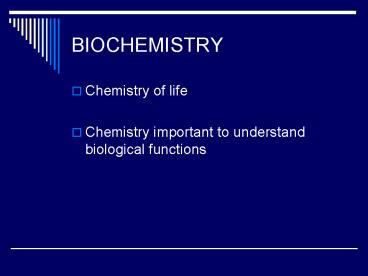BIOCHEMISTRY - PowerPoint PPT Presentation
1 / 18
Title:
BIOCHEMISTRY
Description:
BIOCHEMISTRY Chemistry of life Chemistry important to understand biological functions Some Vocab Matter- occupies space, has mass Element- pure substance- can t be ... – PowerPoint PPT presentation
Number of Views:88
Avg rating:3.0/5.0
Title: BIOCHEMISTRY
1
BIOCHEMISTRY
- Chemistry of life
- Chemistry important to understand biological
functions
2
Some Vocab
- Matter- occupies space, has mass
- Element- pure substance- cant be broken down
into anything else-1 kind of atom - Compound- 2 or more elements chemically bonded
3
Important Elements
- 96 of body is made of 4 elements
- Nitrogen (N)
- Carbon (C)
- Oxygen (O)
- Hydrogen(H)
- Other 4 made of Ca, P, K, S, Mg trace elements
- Needed in tiny amounts- Fe, Se, I
4
Chemistry Review
- Atoms
- Protons ()
- Neutrons (neutral)
- Electrons (-)
- Protons Atomic
- Protons Neutrons Atomic Mass (nucleus)-
- Atoms can have different masses ISOTOPES
5
- Electrons- outside nucleus- in orbitals(energy
levels) - Responsible for bonding
- Atoms can gain or lose 1 or more electrons IONS
6
Chemical Bonds
- Why do atoms bond?
- To fill outermost energy level (stability)
- Atoms can transfer electrons to another atom-
IONIC BOND - OR
- Atoms can share electrons- COVALENT BOND (most
bonds in living organisms) - Hydrogen bonds- well discuss later
7
Modeling Bonds
- Usually a dash is used to represent a bond
between 2 atoms (see board) - This bond is 1 pair of electrons being shared
- If two pairs are shared use 2 dashes
- If 3 pairs are shared- use 3 dashes
8
Draw these molecules
- Examples NH3 CH4 CO2
9
Types of compounds
- Inorganic- contain no carbon-carbon bonds
- 1. Carbon dioxide
- -used as a source of carbon in photosynthesis to
fix energy into sugars - -by-product of animal respiration and some
natural processes - 2. Minerals
- -many are coenzymes- help reactions happen
- -needed in varying amounts to build complex
compounds for life
10
- 3. Water
- -most important inorganic compound for living
organisms - -composes 65-95 of all living organisms
- -provides environments for many organisms
- -has good heat absorbing and releasing
capabilities - -Polar molecule
11
Organic Compounds
- A. Are molecules containing carbon- carbon bonds
- B. Carbon forms the structural backbone of all
major life sustaining compounds - C. Carbon can bond with up to 4 atoms at one
time
12
- D. Can bond with other carbons to form long
chains or rings. - E. Four major groups
- 1. CARBOHYDRATES
- 2. LIPIDS
- 3. PROTEINS (ENZYMES)
- 4. NUCLEIC ACIDS
13
(No Transcript)
14
1
- What 3 subatomic particles compose an atom?
15
2
- Name 2 types of chemical bonds.
16
3
- What are pure substances called that cannot be
broken down into any other kinds of atoms?
17
4
- Atomic tells the number of ________ in an atom.
18
5
- What subatomic particles are responsible for
chemical bonds?





![DOWNLOAD [PDF] Medical Biochemistry PowerPoint PPT Presentation](https://s3.amazonaws.com/images.powershow.com/10133538.th0.jpg?_=20240918087)

![[PDF] Principles of Biochemistry (Lehninger Principles of Biochemistry) Kindle PowerPoint PPT Presentation](https://s3.amazonaws.com/images.powershow.com/10087811.th0.jpg?_=202407290611)























